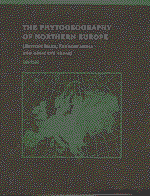Book contents
- Frontmatter
- Contents
- Preface
- Acknowledgements
- 1 Introduction
- 2 Climate
- 3 Edaphic factors
- 4 The geological history of the present European flora
- 5 The atlantic and oceanic elements
- 6 The thermophilic element
- 7 The boreal element
- 8 The arctic, alpine and montane elements
- 9 Endemic, disjunct and centric distribution patterns
- 10 Anthropochorous plants
- Appendix I Calculation of climatic parameters for comparison with plant distributional data
- Appendix II The Northern European species of Flora Europaea with indications of their status and climatic correlations
- Appendix III Arctic species of vascular plants
- Appendix IV Endemic species of vascular plants, bryophytes and lichens
- Appendix V Extra-European disjunctions – bryophytes and lichens
- References
- Index
9 - Endemic, disjunct and centric distribution patterns
Published online by Cambridge University Press: 23 October 2009
- Frontmatter
- Contents
- Preface
- Acknowledgements
- 1 Introduction
- 2 Climate
- 3 Edaphic factors
- 4 The geological history of the present European flora
- 5 The atlantic and oceanic elements
- 6 The thermophilic element
- 7 The boreal element
- 8 The arctic, alpine and montane elements
- 9 Endemic, disjunct and centric distribution patterns
- 10 Anthropochorous plants
- Appendix I Calculation of climatic parameters for comparison with plant distributional data
- Appendix II The Northern European species of Flora Europaea with indications of their status and climatic correlations
- Appendix III Arctic species of vascular plants
- Appendix IV Endemic species of vascular plants, bryophytes and lichens
- Appendix V Extra-European disjunctions – bryophytes and lichens
- References
- Index
Summary
Introduction
Endemics are taxa which occur only in a limited area, for example in the British Isles or in Fennoscandia. Disjuncts are taxa distributed in different areas with considerable gaps in between so that genetic exchange is impossible between the separated populations. Centric distribution relates to limited areas with an extraordinary concentration of endemics and/or disjuncts.
The problems of interpreting endemic or disjunct distribution patterns are, in many ways, very different from the problems of understanding the distribution patterns of the more widespread taxa dealt with previously. In the latter case it is assumed that the distributional area is not limited by the ability of the taxon to spread and that the distribution is therefore limited by environmental factors. This assumption is supported by fossil evidence. Such an assumption cannot be made with respect to endemics and disjuncts. Instead it seems more probable that an explanation of their distributions is to be sought in the history of the populations, namely that they are relicts from earlier, different distribution patterns in the past when the plants could migrate under ecological conditions different from those of today. Such hypotheses should, however, be supported by fossil evidence (Godwin 1975).
In Chapter 4 the history of the flora was outlined based on fossils and geological evidence. The important events to which the flora had to adapt were the Pleistocene glaciations, when ice sheets covered most of Fennoscandia and the British Isles.
- Type
- Chapter
- Information
- The Phytogeography of Northern EuropeBritish Isles, Fennoscandia, and Adjacent Areas, pp. 110 - 148Publisher: Cambridge University PressPrint publication year: 1998



